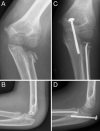Fractures of the proximal radius in children: management and results of 100 consecutive cases
- PMID: 33974141
- PMCID: PMC9296417
- DOI: 10.1007/s00402-021-03917-w
Fractures of the proximal radius in children: management and results of 100 consecutive cases
Abstract
Introduction: Pediatric radial neck and head fractures are rare, accounting for only 1% of all fractures in children. The aim of this study is to describe the management and results of the respective fracture types and different injury characteristics.
Materials and methods: This study performs a retrospective data analysis of 100 consecutive patients with a fracture of the proximal radius treated in a single high-volume pediatric trauma center.
Results: One hundred patients [mean age 7.5 years (1-15)] were documented with a fracture of the proximal radius between 3/2011 and 12/2019. The gender distribution was 62 girls and 38 boys. Twenty-seven patients had concomitant injuries. Conservative treatment was performed in 63 patients (Judet I = 27; II = 30; III = 6; Mason I = 2) using an above-the-elbow cast for 21 days (6-35). Surgical treatment was performed in 37 patients (Judet II = 3; III = 22; IV = 5; V = 7) using elastic stable intramedullary nailing (ESIN). Open reduction was necessary in five cases, and additional immobilization was performed in 32 cases. Six complications occurred: loss of implant stability (n = 2), healing in malalignment, pseudarthrosis, radioulnar synostosis, and a persisting hypoesthesia at the thumb. As a result, two ESIN osteosynthesis were revised, and one radial head resection was performed. Loss of movement was seen in 11% of cases, overall Mayo elbow performance index (MEPI) was 99.8 (90-100), and none of the patients experienced negative impacts on activities of daily life.
Conclusions: Proximal radial fractures occur predominately without dislocation. Good results are obtained with conservative treatment throughout. In cases with displacement exceeding growth-related correction, ESIN is the undisputed treatment of choice. Open surgery and long immobilization periods should be avoided whenever possible.
Keywords: ESIN; Elastic stable intramedullary nailing; Pediatric trauma; Proximal radius fracture; Pseudarthrosis; Radial neck fracture.
© 2021. The Author(s).
Conflict of interest statement
Dr. Markus Dietzel, Simon Scherer, Dr. Michael Esser, Dr. Hans-Joachim Kirschner, Prof. Dr. Jörg Fuchs, and Dr. Justus Lieber have no conflicts of interest or financial ties to disclose.
Figures




References
-
- D'Souza S, Vaishya R, Klenerman L. Management of radial neck fractures in children: a retrospective analysis of one hundred patients. J Pediatr Orthop. 1993;13(2):232–238. - PubMed
MeSH terms
LinkOut - more resources
Full Text Sources
Other Literature Sources
Medical
Research Materials
Miscellaneous

